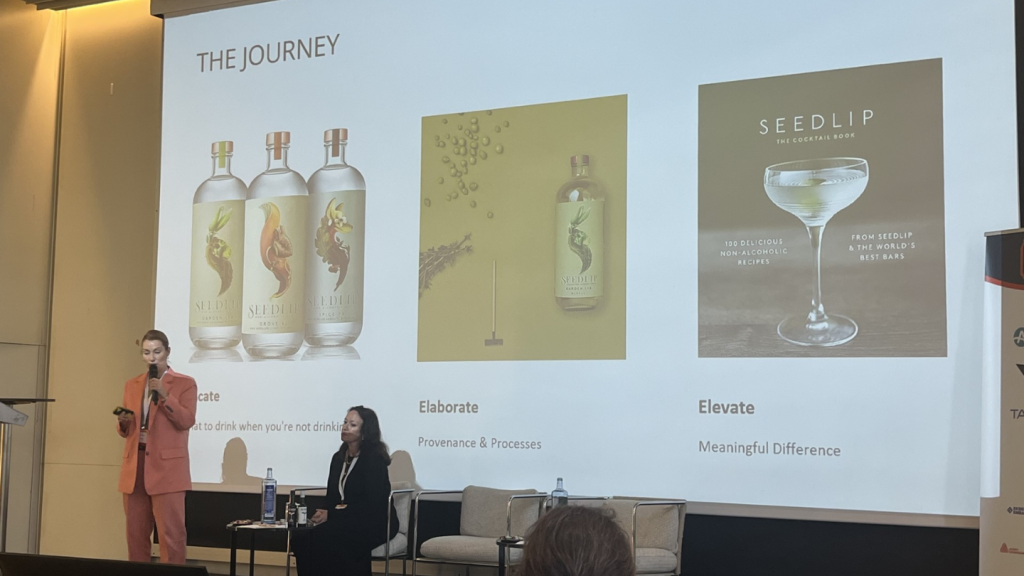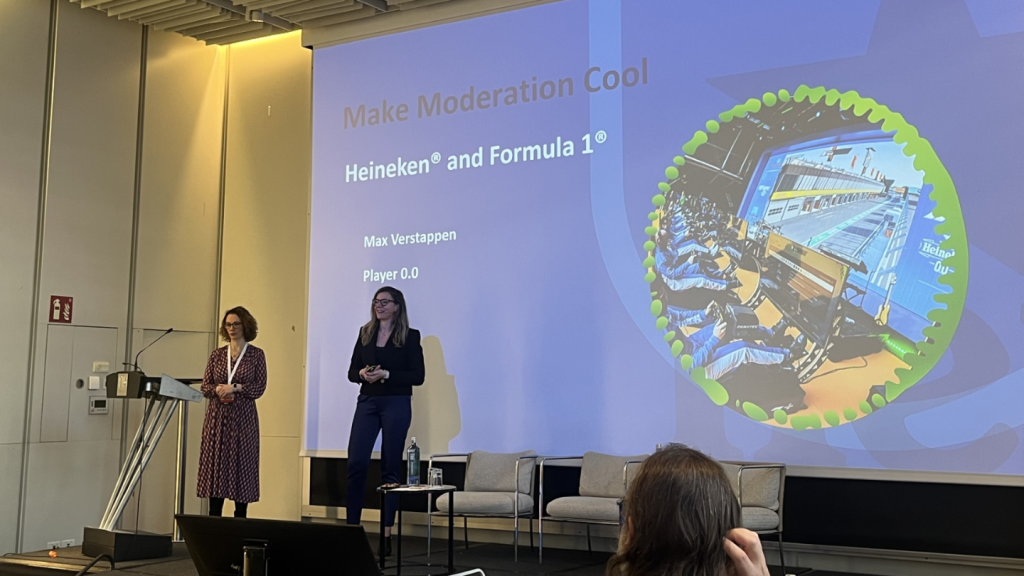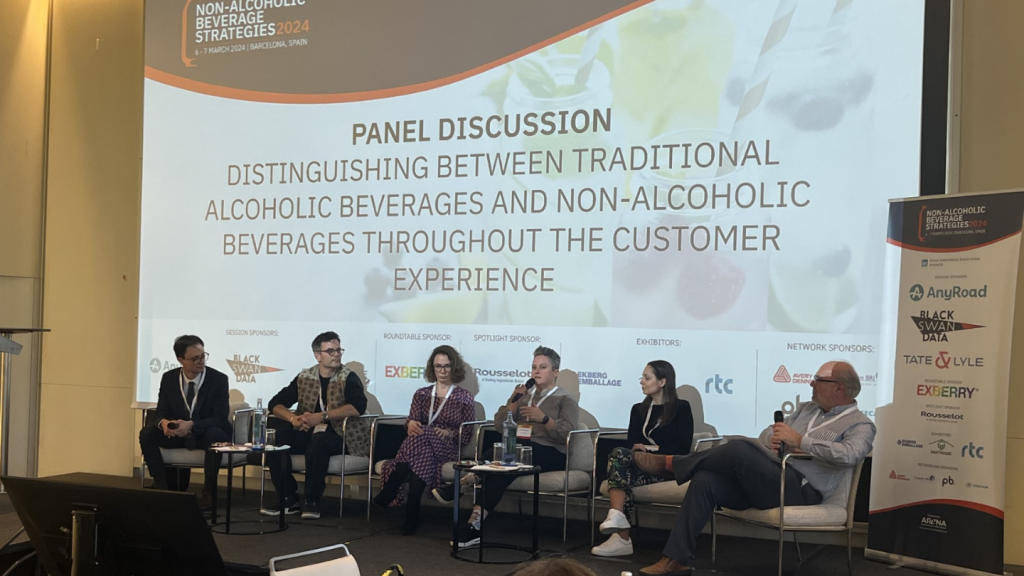
The nascent low-and-no industry appears to be preparing itself for the “second generation” of non-alcoholic products. Product innovation continues in the industry after blowing up in recent years.
Several non-alcoholic executives – both from major alcohol companies and independent businesses – as well as functional soft drinks makers and energy drinks brands all discussed the progression of the non-alcoholic market at Arena’s Non-Alcoholic Beverage Strategies Conference 2024 in Barcelona, presented by Just Drinks.
According to GlobalData, Just Drinks‘ parent, around 75% of people around the world claim to moderate their drinking in some fashion, which shows the steep trajectory that low-and-no is riding.
The two-day event dealt with topics ranging from the difficulty of premiumisation at a time of record inflation to the trends of both physical and mental well-being.
Nevertheless, despite being at an early stage, the fledging low-and-no industry looks set to evolve.
The “second wave”
Since big alcohol players hopped into the non-alcoholic game with 0% abv variations of flagship drinks, like Gordon’s and Tanqueray gin, smaller producers have been looking at innovating.

US Tariffs are shifting - will you react or anticipate?
Don’t let policy changes catch you off guard. Stay proactive with real-time data and expert analysis.
By GlobalDataSeedlip, founded by Ben Branson, was one of the first non-imitation alcohol-free products when it launched in 2015, before Diageo then snapped up the non-alcoholic brand in 2019.

Branson has since co-founded another alcohol-free business, Pollen Projects, which recently completed its first equity financing round.
Pollen Projects CEO Emma Wykes spoke at the Barcelona conference about this upcoming transitional period for the low-and-no sector, adding the venture’s latest brand Seasn – a non-alcoholic cocktail bitters brand – is “riding the second wave”.
She said: “I think when Seedlip launched, there were lots of analogue brands… and when I look at the categories today, the innovation that’s happening, which starts with high-quality liquids, great brands that really deliver something for the consumer, and also really thinking about occasions and thinking about how to create the non-alcoholic versions of those very well-known cocktails that everyone loves.
“I think what’s good about what’s happened in the last eight years is some of these big alcohol brands that have launched non-alcoholic versions have expanded the category which is good for all of us. But now I think there needs to be a real track towards premiumisation.”
The strength (or otherwise) of premiumisation, as a trend, has stuck as a key focus point for both alcoholic and non-alcoholic drinks makers in recent months.
Wykes argued that “there’s £800m ($1.03bn) left on the table every year because we’re not encouraging the [non-alcoholic] consumer to trade up”. Branson even said that the non-alcoholic category is “asleep-at-the-wheel” and premiumisation will help propel it into life again.
Physical and mental wellness
A key trend that has appeared for the low-and-no industry, as well as soft and energy drinks markets, is well-being. More consumers are showing more interest in the links between their diet and their physical and mental wellbeing, partially off the back of Covid, combined with other factors.
A GlobalData survey recently revealed 46% of consumers say they are extremely or quite concerned about their physical health, and 43% say they are extremely or quite concerned about their mental well-being.
Louise Fitzpatrick, global category growth manager at Heineken, noted during the conference that there have been gradual changes in consumers’ definitions of wellness.
Previously, there had been more of a focus on aesthetic well-being and fitness, whereas now people are more concerned than ever about mental wellness, which leads to abstaining from alcohol, she claimed.
“If we look at where things are going today, and particularly post Covid-19, we see that there’s been a much more balanced approach to wellbeing, and that shift from wellness to wellbeing, where it’s more about that holistic balance between that physical, mental, emotional, financial and spiritual wellbeing and all of this coming together to form a greater part of who we are as people and not just our physical health,” she said.
Meanwhile, Lin Peterse, beverages category development manager at ingredients company Tate & Lyle, added consumers are now generally more concerned over natural and healthy elements of beverages than their affordability, despite being cash-strapped.
Influence of Gen Z
Gen Z appears to be a factor in driving the low-and-no industry forward as younger people look to consume alcohol less frequently than previous generations.
In January, a UK survey showed a jump in low-and-no alcohol alternative consumption among young adults in 2023 compared to the previous year.

London-headquartered market research firm YouGov partnered with industry-funded social-responsibility body The Portman Group for the survey, which showed 44% of 18- to 24-year-olds consider themselves either an “occasional or regular drinker of alcohol alternatives”, compared to 31% in 2022.
The value of the market remains small, of course. Across the pond, the value of the fledging US non-alcoholic spirits market could hit $13.3m by 2027. Worth an estimated $8.93m in 2022, the US sold approximately 32,222 nine-litre cases of non-alcoholic spirits that year, according to analysis by GlobalData.
The industry for sure is growing. It’s not quite at the pace that was predicted. We’re at 1.6% of total beer
Louise Fitzpatrick, Heineken
Fitzpatrick claimed during a presentation: “We can see here people are looking at abstaining from alcohol and we know that this trend is even more prevalent among Gen Z. So we define Gen Z as those from the legal drinking age up to 27 years of age.
“They are for sure not the only ones moderating and abstaining. But abstinence is statistically much higher among Gen Z than the average general population. I think in Japan, it’s over 60%, and in the US it’s 55%. In Canada, it’s over 40%.”
Beer leads the way
Non-alcoholic beer has progressed the most since the inception of alcohol-free alternatives. However, as Heineken’s Fitzpatrick discussed, the industry is not at the heights that were originally predicted around seven or eight years ago.
Describing the low-and-no sphere as “so bullish” before Covid, Fitzpatrick said: “It’s fair to say it hasn’t realised that, we haven’t got there. But we are seeing a lot of growth. So the industry for sure is growing. It’s not quite at the pace that was predicted. So some countries are for sure very close to getting to where the aims were.
“So you know, we see in in some markets like if we look at, say the Netherlands where there’s been a huge growth and a huge focus on huge competition. The category is very much growing similarly in Slovakia, some European markets, but globally, we’re at 1.6% of total beer.
“So 1.6% of total beer is non-alcoholic and we do see growth everywhere. But some markets particularly, say the US, UK, South Africa, those kinds of markets have not grown at the levels that were predicted yet. There’s still a lot of time.”
According to GlobalData, the largest market for non-alcoholic beer is Germany at 10.9m hectolitres consumed in 2023 with Japan, Spain and the US following behind.
Low-and-no labelling headaches
Alcohol-free labelling is proving to be a minefield. Different legislations apply to different markets with debates over what can be defined as “non-alcoholic”.
A public consultation on labelling rules was announced last September by the UK government. It called for feedback on a proposal to raise the threshold for an “alcohol-free” drink to an abv of 0.5%, hoping to make alternatives to alcoholic drinks more widely available.
Overall, the consumer is still very confused about non-alc
Emma Wykes, Pollen Projects
Currently, “alcohol-free” drinks in the UK must have an abv of 0.05% or less. Meanwhile, “low-alcohol” refers to any product with 1.2% abv or below.
Laura Willoughby, the co-founder of the alcohol-free retailer and bar Club Soda, said the consumer currently believes “alcohol-free” drinks must have an abv of 0%.
“Really, if the category wanted to come together, everybody would talk about 0% to 0.5% [abv] being alcohol-free and there being a range of products within that,” she said during the Barcelona conference.
“I wouldn’t say that everybody is exactly on the same page. I’d love for everybody to be on the same page because I think, in the longer term, that’s where the growth and choice will be.”

Morten Sørensen, founder of Danish non-alcoholic company Ish, agreed with the Club Soda founder and said every company should try to make it “more smooth and make it easier, especially for the consumer”.
During another presentation, Crossip co-founder Tim Blake argued the terminology behind non-alcoholic drinks was needlessly confusing for the consumer.
He said the term ‘spirit’ should be defined by its purpose rather than production process.
“For me, it’s now about what things do rather than what they are. The easiest way to think about it is, yes, 'spirit', if you look in the dictionary, it definitely has to be distilled. I’m not going to dispute any of those things. But then now what a spirit does is it becomes the base of the drink, the foundation for every great drink and that’s all that should matter.”
The nebulous nature of labelling and terminology echoed around the conference, with low-and-no producers asking for clarity.
Heineken’s Fitzpatrick added education for the consumer is paramount for growing the non-alcoholic industry, but, as others alluded to, this is proving harder than first thought with obstacles like labelling rules in the way.
Wykes added: “I think though overall the consumer is still very confused about non-alc. If you speak to most on-trade operators in the UK, they know they need to offer it but how is it served?
“As a category, because we’re still so young, we’re under ten years old, we need to collaborate more.”
--
Interested in knowing more about the beer industry and meeting industry leaders including Carlsberg, Asahi, AB InBev, Mahou San Miguel, Bitburger Braugruppe and Super Bock? Join us in Porto on 14 -16 May for the International Beer Strategies Conference.



